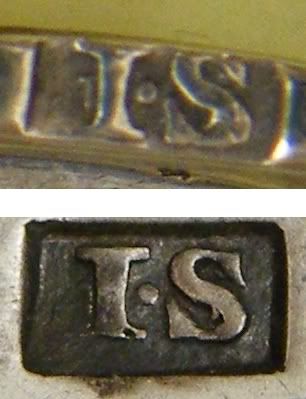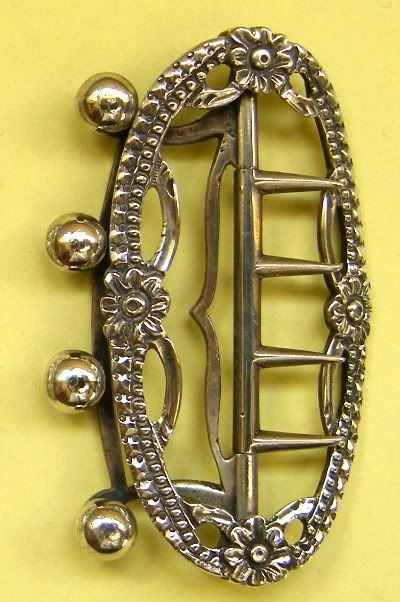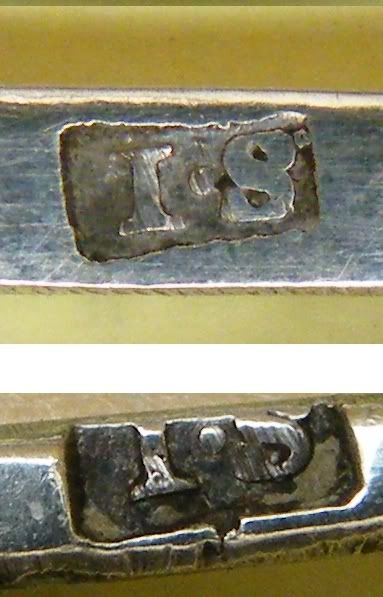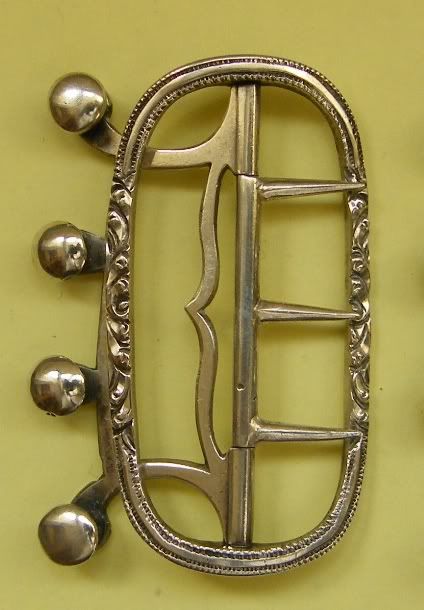Page 1 of 1
Help required to identify this stock buckle maker, please.
Posted: Tue Feb 10, 2009 11:14 pm
by magpie



I believe this stock buckle was made in London between 1756 and 1784 as the lion appears to be correct for that period and there is no duty mark. The maker's mark is a little more difficult. The initials are IS with a pellet between. I don't think they are SI. It doesn't look right up the other way. In Grimwade the marks for buckle makers are not illustrated. I did wonder if it could be John Stone, 1776 as the corners of the stamp aren't square.
.
Posted: Wed Feb 11, 2009 6:55 am
by buckler
I concur it is almost certainly IS rather than SI . There are so many IS marks possible though !
My guess is James Stamp or James Sutton but they are only the most likely of several possibilities.
One problem is that bucklemakers were notoriously an ill discipline lot , even for a era where strict adherence to the rules could not be enforced and was often flouted. Thus there were a lot of unregistered secondary punches out there.
Stylistically probably 1770 - 1790. On stock buckles there is some evidence that there were many stock buckles assayed after 1784 without the duty mark. In Birmingham it has been shown that, entirely contary to law, they assay marked excempt items and did not pay the duty. I think the same applied in London, the bucklemakers claiming stock buckles were excempt (wrong) and that they could have them thus be assay marked and not pay duty (double wrong!)
James Stamp
18 April 1764
Joint Smallworkers mark as James STAMP & John BAKER at Cow Cross (D2/p14Ca)
Parnership moved to Ludgate Street by early 1765, and another partnership mark entered in 1768
Heal records the partnership dissolved in 1770 .
Certainly on 11 April 1770 John BAKER entered a solo mark as a smallworker at 5, Old Bailey (D2/p14Cb)
James STAMP in PR1773 as Plateworker alone at 86, Cheapside (E2/p15Bc)
6 July 1774
Solo mark of James STAMP as Plateworker at 86, Cheapside
Many new punches registered 1776 -1779
Died 11th April 1780 . Will PROB11/1064
His widow, Frances STAMP, registerd a mark 12th May 1780 as plateworker at 86, Cheapside
According to Heal in 1780 the premises were run by "James and Francis (sic) Stamp"
86, Cheapside were quickly taken over by James SUTTON who registered a mark as plateworker there on 7 July 1780
James Sutton
7 July 1780
Plateworkers mark at 86, Cheapside "next door to the Mercers Chapel" (E2/p15Bc) Horwoods map shows that No 88 and No 86 were on the north side of Cheapside, each on either side of an unnamed building shown as part of the Mercers Hall. One assumes this is the Mercers Chapel
4 October 1782
Joint mark as Bucklemakers James SUTTON & James BULT at 86, Cheapside
Sutton and Bult were listed as bankrupt in July 1784
3 November 1789
London Gazette Issue 13146 James Sutton to be granted his certificate
03 January 1792
William & James Sutton were signatory to Bucklemakers Petition to the Prince of Wale
William Sutton , probably Jame's brother registered a smallworkers mark at 85, Cheapside on 26 August 1784
86, Cheapside then operated by Samuel Godbehere from late 1784, in assorted partnerships. One suspects that many of the old IS punches may still have been used throught the entire period .
86, Cheapside was in one of the best retail areas of London. Although the City was becoming less fashionable , losing out as the quality moved west.
.
Posted: Thu Feb 12, 2009 12:44 am
by magpie
Thank you for your reply and information. You have confirmed what I suspected, it is practically impossible to work out who made the buckle. Is James Stamp known to have made buckles? What about all the buckle makers listed in that section of Grimwade. Are their marks listed anywhere. Also I am not sure how accurate the illustrated marks are with regard to size, letter shape and so on.
If the mark is actually meant to be SI then the mark 2555 for Stephen Joyce is pretty close. Was he a buckle maker? Is there any convention in the way stamps were placed on these buckles. As the base of the lion stamp is on the outside edge, perhaps the maker mark would have been stamped the same way.

I have added two photos of the case the buckle was in when I got it. Does it look like the original case? If so does the case add anything as far as determining the date is concerned?


Linda
.
Posted: Thu Feb 12, 2009 10:31 am
by buckler
My shortlist for this mark on a buckle would be Joseph Sutton, Joseph Stainforth , John Stone , James Smith, John Stocker, (all with marks registered as bucklemakers pre 1785 ) ,James Sutton , Joseph Steward (No 2) or James Stamp. Your suggestion of Stephen Joyce is certainly not impossible.
The problem with the so-called makers mark on silver after around 1750 is that it is often no longer the mark of the actual maker ! The modern expression "sponsors mark" is more accurate. James Stamp never registered a mark as a bucklemaker, but as a very fashionable retailer he sold a lot of buckles, probably mostly made by outworkers, marked with his mark, assayed and perhaps finished off in his factory by his own chaser journeymen. That's why your marks are so close to the edge on this stock buckle - the buckle was not finished until after assay. Main reason is that if a buckle failed assay , then the expensive labour of chasing and finishing was not lost. The same applies in particular to piercing - items were always assayed before the very expensive piercing was done . Another problem is that I have a suspicion that registering a mark as a bucklemaker was, for some reason, an advantage. It did not reduce your assay charges but I am fairly sure it reduced some other costs at Goldsmiths Hall.
My guess is that the case is post 1800 and not originally associated with the stock buckle.
If this all seems a bit vague , I agree with you !
I have been researching and collecting Georgian buckles for years now - and I know far LESS now than when I started.
.
Posted: Fri Feb 13, 2009 8:45 pm
by magpie
Thank you again.
Of course it is not that you know less now, it is just that you are more aware of how much there is to learn. I am starting to feel the same.
.
Posted: Sat Feb 14, 2009 7:55 am
by buckler
The sun has come out in England and I can use the camera at last .
For interest, here are two other stock buckles with an IS mark. Note that even allowing for my poor close up skills you can see apparent individual differences for the marks on the same buckle, let alone between buckles ! We may have on this site three buckles with one, two or even three makers.
Nr 293
This buckle has a nick out of the bottom loop of the "S" clearly visible on both marks , but the bottom of the "I" has an indent only on one mark


Nr 824
The stock buckle below was bought with the prongs missing but, as the bar pivot remained, one could see the original positions of the three prongs. I sometimes buy wrecked stock buckles for study and had some prongs of the right length and period. The guy who did the repair said afterwards it was a hard task, but by the time he'd finished he'd found the technique that the 18th century silversmiths used. Personally I think he did a splendid job, especially as he had to avoid ruining the patination. It's the top prongs he got virtually right. The prongs may be a millimetre too long. The silversmith's comments are unprintable on how accurate and tight the tapers on the saddlepin holes were. Removal was a nightmare and his admiration for the original accuracy unbounded. Although I suspect that much of his vocabulary was used in the process.


.
Posted: Sun Feb 15, 2009 7:04 pm
by magpie
The indentation in the "I" on the second mark could perhaps just be damage during use.
Has this buckle been stamped twice? There is part of a smaller letter to the left of the "I" and the irregularity to the lower part of the "S" could be the result of a double stamp.
Until I bought my buckle on a local auction site I had never heard of stock buckles and the person selling it didn't know what it was. I think I have seen a couple on a British web site but nowhere else. How common are they? How easy is it for you as a collector to find a silver stock buckle in good condition?
.
Posted: Tue Feb 17, 2009 5:55 am
by buckler
Hi magpie.
Agreed that the lower indent could well be subsequent damage.
All stock buckles should have an assay and makers mark on both the chape and the frame. But not all do !
The slight shadow marks to the left of the "I" are a mystery. I doubt very much if they are an overstrike but cannot account for them. Overstrikes are not common on buckles, although they do exist. One problem is that often a silversmith will slightly mispunch and either have another go, or the punch will judder.
Stock buckles, as I am sure you know , were to secure the high cravat-like neckcloth of the gentleman at the back of his neck. Before 1770-ish an alternative, a pair of clasps, could be used at the front. These are very rare survivors, I've only seen 4 in the last ten years. (Curiously 3 of them last year !). Stock buckles are not rare, although not nearly as common as shoebuckles. Until comparatively recently they were also fairly cheap, but prices have doubled in the last eighten months, mainly due to the demands of costume re-enactors, especially in Germany and Austria.
Stock buckles changed but little over the years in basic form, and were only seen by the man, his wife , the man's valet, and the odd thief. As a result they were not scrapped for new fashions as often as shoe buckles and far more pre 1756 stock buckles survive than do shoe or knee buckles.
There are two main fixings for the stock buckle. The English form which is either three or four studs - like the ones above, and the continental- which is a series of miniature anchors in place of the studs. Americans used either, and I've a supposed Scottish speciment that uses the anchors. British silversmiths have been known to use anchors on those exported to France.
There is a theory is that these buckles are actually for hats but I see no evidence for this whatsoever, and much against. But I have been known to be wrong.
.









